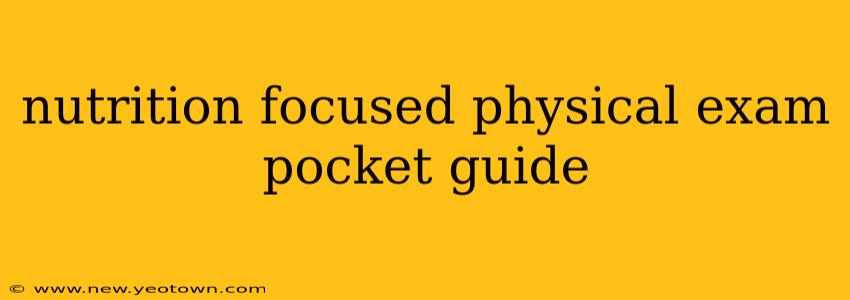This isn't your typical, dry medical textbook. This is a story – a story about how a seemingly simple physical exam can unveil a world of nutritional deficiencies and insights into a patient's overall well-being. Imagine yourself, a healthcare professional armed with knowledge, stepping into an exam room. You're not just looking for symptoms; you're searching for clues – subtle signs that point to nutritional imbalances. This pocket guide is your compass, leading you through the process.
General Appearance: The First Impression
Our story begins with the first glance. The patient walks in, and before you even ask a question, your trained eye starts taking in details. Are they frail? Obese? Do they have edema (swelling)? These aren't just observations; they're potential red flags. A patient with significant weight loss might be struggling with malnutrition. Conversely, excessive weight gain could indicate dietary issues contributing to obesity and related health problems. Edema points to potential fluid retention, possibly linked to protein deficiency. This initial assessment lays the foundation for a more thorough examination.
What are the common signs of malnutrition?
Malnutrition manifests in various ways, not just weight loss. Look for things like dry, brittle hair, pale skin, easy bruising (possibly vitamin C deficiency), and impaired wound healing (indicating deficiencies in protein and other nutrients). These subtle clues often precede more serious complications, and early detection is key.
How do I assess for obesity during a physical exam?
Assessing obesity goes beyond just weighing the patient. Note their body mass index (BMI), waist circumference, and body fat distribution. A large waist circumference, even with a normal BMI, is a significant risk factor for various health problems. Understanding the distribution of body fat – abdominal vs. peripheral – provides additional insight into metabolic risks.
Skin, Hair, and Nails: A Window to Nutritional Status
Let's delve deeper. The skin, hair, and nails often mirror nutritional deficiencies. Dry, flaky skin could indicate a lack of essential fatty acids. Brittle, easily broken nails might suggest a deficiency in iron, zinc, or biotin. Hair loss or thinning can also point to several nutrient deficiencies. This detailed examination adds another layer to your understanding of the patient's nutritional status.
What are some common skin changes associated with nutrient deficiencies?
Several skin changes can signal nutritional issues. For example, angular cheilitis (cracks at the corners of the mouth) might point to riboflavin or iron deficiency. Pellagra, characterized by dermatitis, diarrhea, and dementia, is a severe niacin deficiency. Recognizing these specific signs helps you narrow down possible deficiencies.
Musculoskeletal System: Strength and Weakness
This stage involves evaluating muscle mass and strength. Muscle wasting (sarcopenia) is a common finding in malnutrition. Weakness and fatigue can stem from deficiencies in various vitamins and minerals, such as vitamin D, iron, or magnesium. Assessment should include muscle strength testing, identifying any potential mobility issues that could be linked to nutritional status.
Neurological Exam: Subtle Clues
Surprisingly, neurological symptoms can also indicate nutritional deficiencies. Peripheral neuropathy (nerve damage) might be linked to diabetes, often rooted in dietary habits. Cognitive impairment could be associated with deficiencies in B vitamins. A thorough neurological exam, while not solely focused on nutrition, can unearth crucial information related to overall well-being.
Can neurological symptoms be related to nutritional deficiencies?
Absolutely. Beriberi, for instance, is a severe thiamine deficiency causing neurological symptoms like weakness, paralysis, and even heart failure. Similarly, vitamin B12 deficiency can lead to peripheral neuropathy and cognitive impairment. This highlights the interconnectedness of seemingly disparate systems within the body.
Conclusion: The Power of Observation
This nutrition-focused physical exam is more than a checklist; it's a journey of observation and interpretation. It’s about connecting the dots – noticing the subtle clues that speak volumes about a patient's nutritional status. By combining a keen eye for detail with a comprehensive understanding of nutritional deficiencies, you can effectively identify potential problems and guide your patients towards a healthier future. This isn't just about diagnosing; it's about empowering patients with the knowledge they need to make informed choices about their diet and well-being. Remember, this pocket guide is your starting point. Continue your learning and stay updated with the latest research in nutritional science to deepen your expertise.

